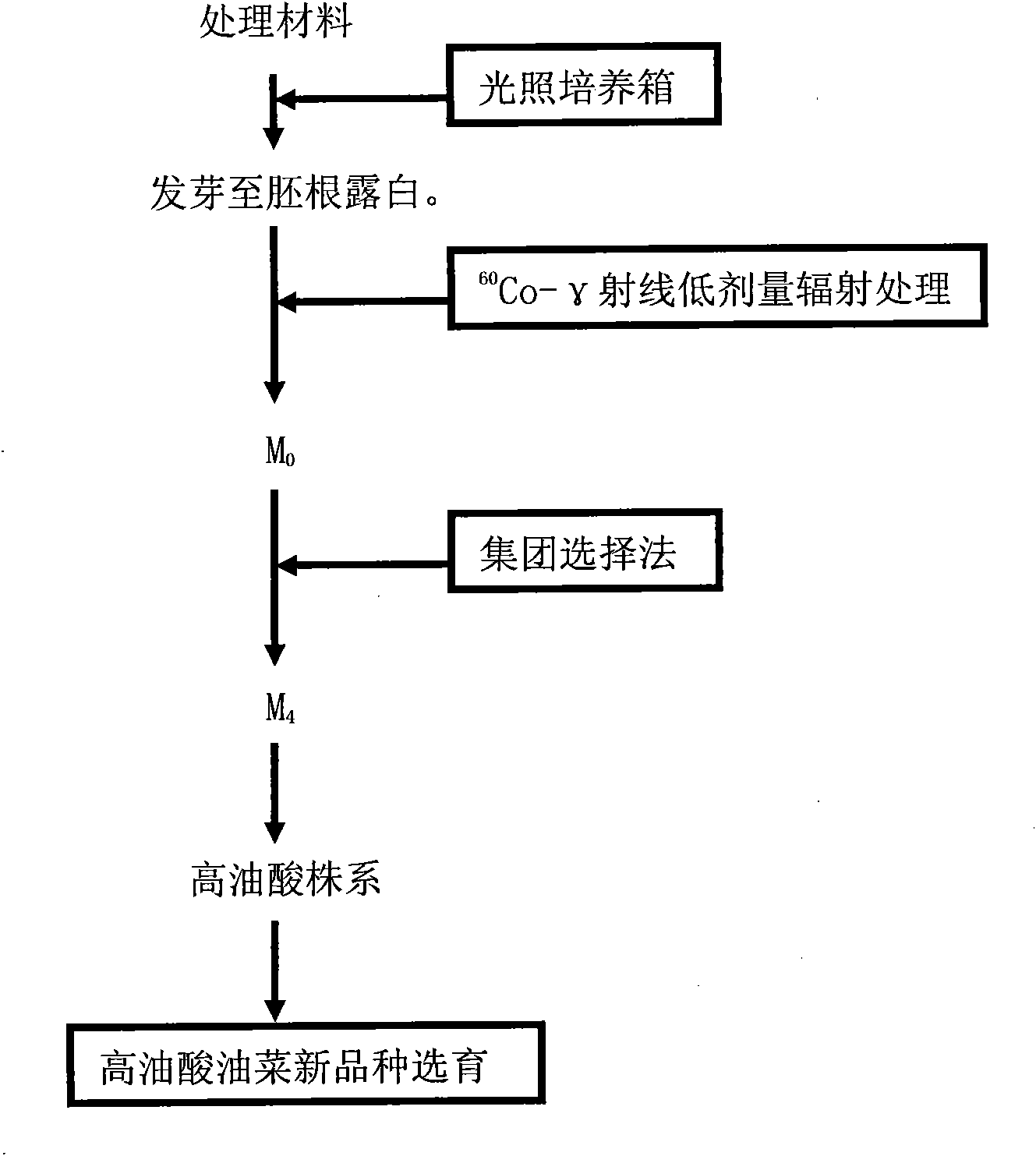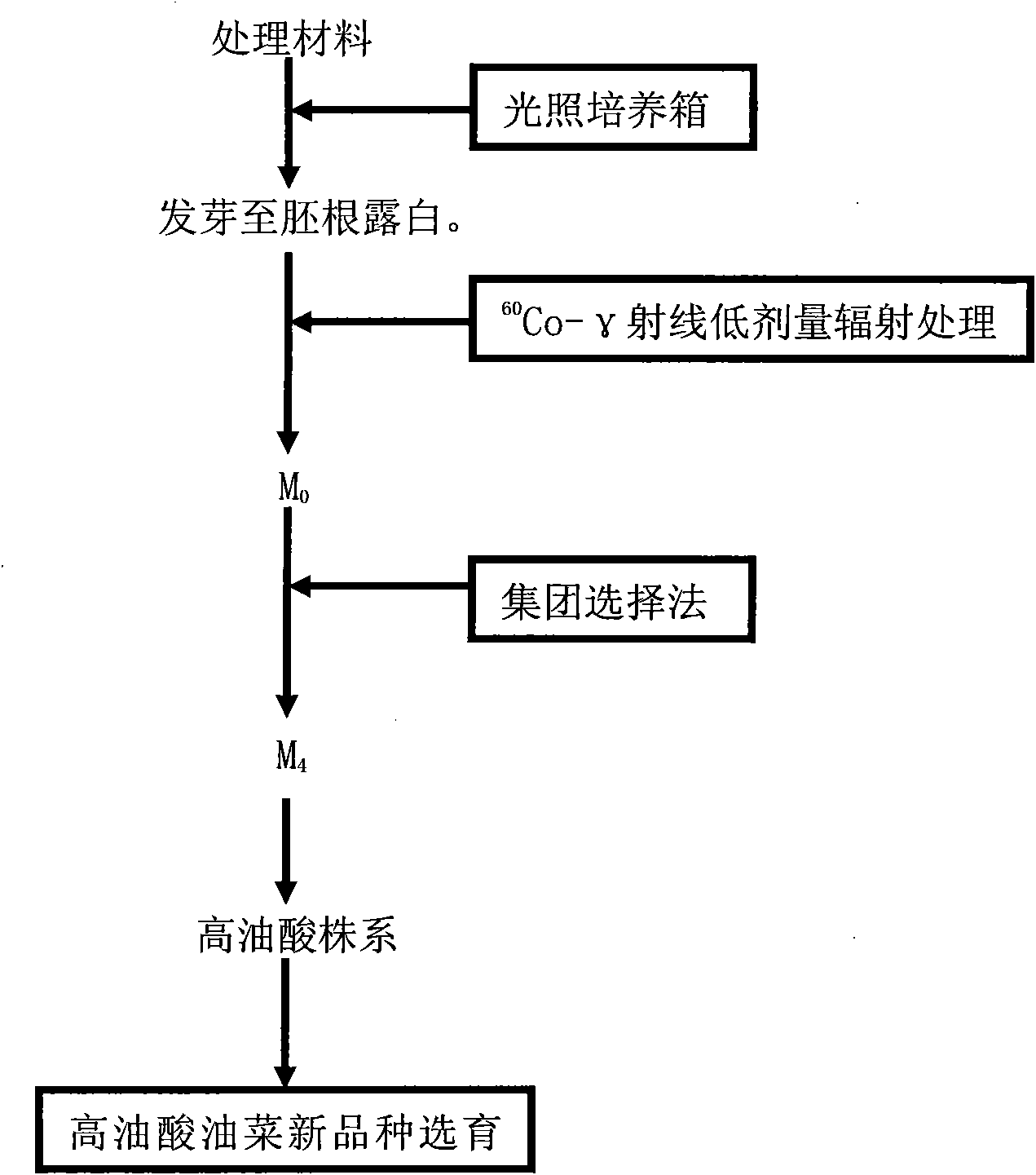Method for creating new high oleic acid germplasm by treating rape germinating seeds with low-dose <60>Co-gamma rays
A high oleic acid, gamma ray technology, applied in seed and rhizome treatment, botanical equipment and methods, plant genetic improvement, etc., can solve problems such as heavy workload, long selection cycle, and poor agronomic traits
- Summary
- Abstract
- Description
- Claims
- Application Information
AI Technical Summary
Problems solved by technology
Method used
Image
Examples
Embodiment 1
[0018] The radiation-treated material is the rapeseed line L13-306-171 obtained by hybridization between varieties (publicly known and public, see Brassica napus for further improvement of octadecenoic acid, Journal of Jiangsu Agricultural Science, 1995, 11(1): 16-20). The material is the low erucic acid rapeseed PL-0256 bred in this selection as the female parent, and the low linolenic acid rapeseed DN-1792 introduced from Canada as the male parent. Single plant selection and half-grain method were used for the offspring of the combination for 4 consecutive years Combining screening, positive selection for oleic acid content and negative selection for linolenic acid content, a new rapeseed line with oleic acid content of 72.21% was bred in 1995. From 1996 to 2003, we carried out directional selection and self-breeding homozygosity on L13-306-171 for 8 consecutive years to further increase the oleic acid content, but the breeding effect was very limited, the improvement of fatt...
Embodiment 2
[0020] Put the selected seeds of L13-306-171 in a moist petri dish, 100 seeds per dish, a total of 400 seeds in 4 dishes, and germinate in a light incubator at 25°C. Institute of Atomic Energy, Academy of Sciences 60 Co-γ-ray low-dose treatment, the radiation dose is 80Gray. The germinated seeds after radiation treatment continued to germinate in a light incubator at 25°C. When the radicle elongated and the germ grew to about 1cm, the buds were planted in the field. The row length of the field was 3.3m, and 25 plants were planted in each row. After the spring rape blossoms, each normal flowering plant is bagged and self-bred, and more than 200 mature plants are finally harvested. Bud planting in a large field must be intensively cultivated. The soil clods must be fully broken, thinned, and leveled. Before planting, water enough to make the soil moist. Clamp gently, and put the radicle of the seedling vertically into the small hole, press the radicle around with soil, cover w...
Embodiment 3
[0022] For the L13-306-171 radiation progeny material, 5 consecutive generations of group positive screening were carried out, and the M 0 During the flowering stage of rapeseed, select well-grown plants for bagging and self-crossing. After the plants mature, 201 single-plant seeds of bagging and self-crossing are harvested, and the total fatty acid components are analyzed by gas chromatography. The oleic acid content varies from 68.75% to 78.81%, according to the content of oleic acid in fatty acids from high to low, 30 high oleic individual plants were selected, and the oleic acid content ranged from 76.23% to 78.81%. These 30 high oleic individual plants were mixed with the same amount of seeds and sowed in the field in autumn , as the selection group for the next generation. in M 1 A total of 578 bagged and self-bred single plant seeds were harvested, and the oleic acid content ranged from 56.14% to 84.90%. According to the oleic acid content in fatty acids from high to l...
PUM
 Login to View More
Login to View More Abstract
Description
Claims
Application Information
 Login to View More
Login to View More - R&D Engineer
- R&D Manager
- IP Professional
- Industry Leading Data Capabilities
- Powerful AI technology
- Patent DNA Extraction
Browse by: Latest US Patents, China's latest patents, Technical Efficacy Thesaurus, Application Domain, Technology Topic, Popular Technical Reports.
© 2024 PatSnap. All rights reserved.Legal|Privacy policy|Modern Slavery Act Transparency Statement|Sitemap|About US| Contact US: help@patsnap.com









